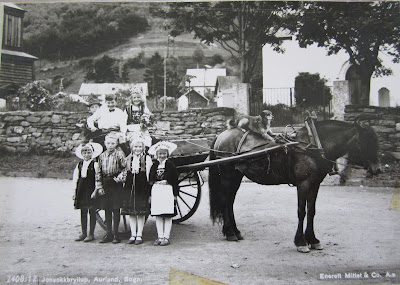Jonsokkbryllup, Aurland, Sogn, Norway
[Summerfest wedding postcard: courtesy of Lorraine Becker]
[Summerfest wedding postcard: courtesy of Lorraine Becker]
Last week the Gimlets and I took a trip to visit my mother’s sister. She brought out some photo albums and among the things she had was this postcard. It is more recent than previous cards I have posted on Thursdays. I think Dick Thompson purchased it in the 1950s when he took a trip to Norway.
We are well past midsummer but the picture is quite charming from the children dressed up in costume to the dog riding on the back of the Fjord horse. The dog looks so relaxed it made me wonder if he often rode up there. The bride is wearing a crown and two of the little girls are wearing the local skaut headdress of a married woman. The boys in the photo look dressed up but not necessarily in the local bunad.
The caption at the lower left says “Jonsokkbryllup”-- St. John’s Day or Midsummer wedding. Midsummer festivities have been held in many countries for hundreds of years. They usually include a large bonfire, dancing and singing. A tradition from the area near Bergen, Norway (I’m not sure if this is done in other parts of the country) includes mock weddings sometimes between adults but more often between children. These weddings symbolize a new beginning with the rising of the sun on the longest day of the year and can be held between the 20th and the 25th of June—the Summer Solstice. The children dress up in the area bunad and get a ride in a horse or pony drawn wagon as seen on the card. Perhaps the cart ride may be enough of an incentive for the children to get dressed up? They do look extremely cute.
I wondered a bit why it was called “John’s” wedding but then realized that the birthday of John the Baptist was supposed to have been six months prior to the birth of Jesus. The holiday is also sometimes referred to St. Hans Day in Norway. The name Hans is another version of John. Although the holiday has a Christian name I suspect Midsummer celebrations predate Christianity and were just incorporated into the religious calendar for convenience since the people were accustomed to having it.
The postcard is from Aurland north of Bergen in Sogn Fjordane county. The white church at the right side of the top card and shown below on a second postcard is called Vangen Church built in 1202. Dick had cousins living in Aurland but I have not yet been able to identify them. His mother came from Sogn og Fjordane so perhaps these cousins are from her side of the family although we do know that his half-brother Gjert Didriksen lived in the general area as well. Dick did mention that he had two brothers but did not indicate if he had met them. His father’s family came from Rogaland south of Bergen. Enørett Mittet & Co published both of the cards shown.
Vangen Church, Aurland, Sogn og Fjordane, Norway
[postcard: courtesy of Lorraine Becker]
[postcard: courtesy of Lorraine Becker]
I thought it was interesting that this church is built in an early
Gothic style that shows English influence. Apparently English merchants
used to stay in Aurland and they are suspected to have helped in the
building of the church, perhaps even as the master builders. Two of the stained glass windows, one of the
Parable of the Prodigal Son and the other of Jesus Christ, the Savior,
were made by the multi-talented Norwegian artist Emanuel Vigeland. Vigeland was
mostly known for his paintings but he did frescos, stained glass, and
sculptures as well. His younger brother Gustav Vigeland was also an
artist. Gustav Vigeland’s famous sculpture garden in Oslo depicts the
life cycle of mankind.
The scenery in all of Norway is very beautiful. The picture below is of the Aurlandsfjord.
The scenery in all of Norway is very beautiful. The picture below is of the Aurlandsfjord.
Aurlandsfjorden, Aurlandsvangen, and Flåm
[photo: Wikipedia—http://en.wikipedia.org/wiki/Aurland]
[photo: Wikipedia—http://en.wikipedia.org/wiki/Aurland]



No comments:
Post a Comment